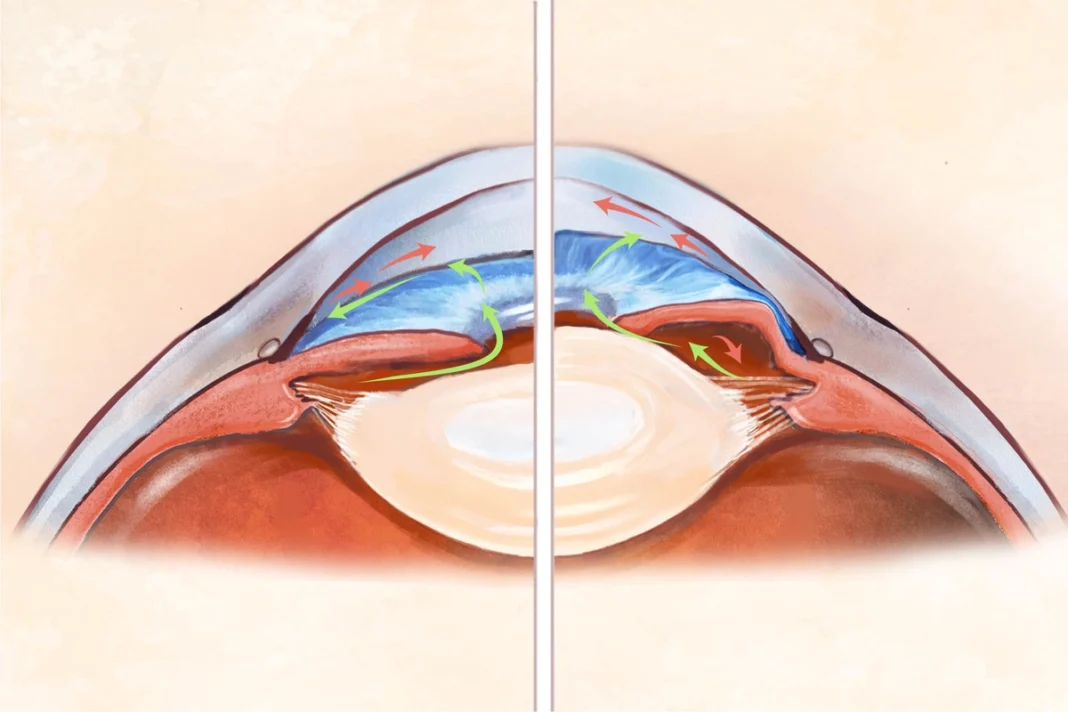|
Getting your Trinity Audio player ready...
|
Affecting over 3 million Americans, glaucoma is an eye disease that can lead to vision loss or blindness caused by fluid buildup in the front of the eye.
By: Mercura Wang
Glaucoma is a group of eye diseases that can lead to vision loss or blindness by damaging the optic nerve at the back of the eye. This damage typically occurs due to increased pressure caused by fluid buildup in the front part of the eye, harming the optic nerve over time. Glaucoma ranks as the second most common cause of blindness globally (next to cataracts), affecting over 3 million Americans.
What Are the Types of Glaucoma?
There are two main categories of glaucoma: primary and secondary. Primary refers to cases where the exact cause of the condition is unknown. When other medical conditions cause glaucoma, it’s called secondary glaucoma.
Primary
Primary open-angle: Open-angle glaucoma is the most common type in the United States, comprising 90 percent of all glaucoma cases. It is characterized by damage to the optic nerve, a wide anterior chamber angle (the space between the cornea and the iris surface), and increased intraocular pressure (IOP; eye pressure) of over 21 millimeters of mercury (mmHg). This type of glaucoma is a significant cause of blindness, particularly among African Americans, where it accounts for nearly 20 percent of all cases.
Normal-tension: Normal-tension glaucoma is a form of open-angle glaucoma that occurs in people with regular eye pressure (below 21 mmHg). In the United States, between one-third and one-half of people with glaucoma have this type.
Angle-closure: Also called narrow-angle or acute glaucoma, angle-closure glaucoma is a medical emergency. It accounts for approximately 10 percent of all glaucoma cases in the United States.
The “angle” is where the iris and cornea meet at the outer edge of the anterior chamber. Angle-closure glaucoma occurs when the outer edge of the iris obstructs fluid drainage from the front of the eye, leading to rapid fluid buildup and a sudden rise in pressure. Without prompt treatment, this type of glaucoma can result in severe vision loss or blindness within a few days. Chronic angle-closure glaucoma progresses gradually and may not exhibit symptoms other than vision loss.
Primary congenital: Primary congenital glaucoma is a rare condition resulting from improper development of the aqueous drainage system before birth. It affects approximately 0.01 percent of babies born in the United States.
Secondary
Other medical conditions, such as cataracts, tumors, diabetes, eye surgery complications, and the use of certain medications can also cause the following glaucomas:
Neovascular: Neovascular glaucoma occurs when excessive blood vessel growth obstructs the eye’s drainage area, typically due to underlying medical conditions such as diabetes or high blood pressure.
Pigmentary: Pigment dispersion syndrome occurs when pigment rubs off from the back of the iris, potentially increasing eye pressure and causing pigmentary glaucoma.
Exfoliation: Exfoliation glaucoma, also known as pseudoexfoliation glaucoma, is a form of secondary open-angle glaucoma occurring in individuals with exfoliation syndrome. This syndrome leads to the accumulation of cellular material on various parts of the eye, thus obstructing fluid drainage.
Uveitic: Uveitic glaucoma is a common complication of uveitis, which causes eye swelling and inflammation. Around 20 percent of people with uveitis develop uveitic glaucoma. Experts believe inflammation and scar tissue formation in the eye’s middle region may block fluid drainage, leading to increased eye pressure, uveitic glaucoma, and eventual vision loss.
Secondary childhood: Secondary childhood glaucoma results from an eye developmental anomaly unrelated to the aqueous drainage system, a syndrome, or another eye condition.
Some individuals may have increased eye pressure without visible damage. These patients are called “glaucoma suspects” as they have an increased risk of developing glaucoma later on. Even those with normal eye pressure may be considered glaucoma suspects if their optic nerve shows unusual characteristics. However, most glaucoma suspects do not experience symptoms, underscoring the importance of regular monitoring by an ophthalmologist.
What Are the Symptoms and Early Signs of Glaucoma?
Glaucoma often begins without noticeable signs, so 50 percent of those affected are unaware of their condition. As it progresses, vision loss typically begins with peripheral vision, which may go unnoticed initially due to its slow development. Without intervention, glaucoma can lead to blindness.
The specific symptoms also vary depending on the type of glaucoma, as indicated in the following:
Primary open-angle: This type is nicknamed “the silent thief of sight” as patients often experience no symptoms until vision damage becomes significant when blind spots start developing in the side vision. The symptoms include increased IOP and tunnel vision.
Normal-tension: Patients typically don’t experience symptoms until it’s too late, which is the same for people with open-angle glaucoma (except open-angle exhibits elevated IOP). Patients may also experience bleeding in the nerve fiber layer of the optic disc.
Angle-closure: Symptoms include severe eye pain, nausea, red eye, and blurred vision. If you suddenly experience these symptoms, seek medical attention immediately.
Primary congenital: Children diagnosed with congenital glaucoma often exhibit cloudiness in their eyes, light sensitivity, abnormally high tear production, and possibly larger-than-normal eye size.
Neovascular: Symptoms include eye pain or redness and loss of vision.
Pigmentary: Individuals with pigment dispersion syndrome or pigmentary glaucoma may experience halos (rainbow-colored rings around lights) or blurred vision following activities such as jogging or playing basketball.
Exfoliation: While exfoliation glaucoma shares the same symptoms as primary open-angle, it can advance more rapidly and frequently results in increased eye pressure.
Uveitic: Uveitic glaucoma can damage the optic nerve and induce a loss of visual field. Patients with it experience symptoms of both uveitis and glaucoma, including red eyes, pain, sensitivity to light, spots in vision, and blurred vision.
What Causes Glaucoma?
In glaucoma, retinal ganglion cells and nerve fibers in the optic nerve are gradually lost. This leads to a telling appearance of the optic nerve head and progressive vision decline. The pattern of peripheral vision loss is a key feature that sets glaucoma apart from other eye conditions.
Researchers believe that glaucoma occurs when there’s too much aqueous humor, the fluid that nourishes the eye, leading to high pressure (IOP) inside the eyes.
Usually, this fluid moves like water filling a sink. The faucet (the ciliary body) produces it, and drains (drainage canals) remove it from the eye to maintain a normal fluid level. As drainage canals become clogged, the fluid doesn’t drain properly, resulting in an imbalance. When pressure becomes abnormally high, it harms the optic nerve, leading to glaucoma.
Low- or normal-tension glaucoma can occur when eye pressure is within the normal range but still too high for the optic nerve.
Certain factors put people at higher risk, including:
Age: African Americans 40 years old and above and people of all ethnicities who are 60 years old and above (particularly Hispanics) are at a higher risk of developing glaucoma. Males in their 30s are at the highest risk for pigmentary glaucoma, with the ratio of males to females ranging from 2:1 to 5:1, depending on the study.





